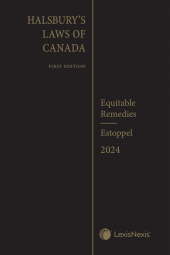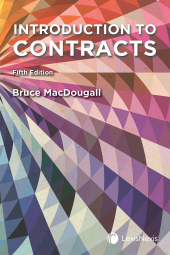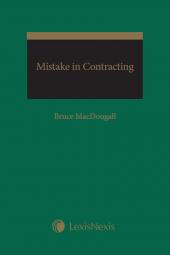Mistake in Contracting
One Year Subscription Only Terms
Subscribers receive the product(s) listed on the Order Form and any Updates made available during the annual subscription period. Shipping and handling fees are not included in the annual price.
Subscribers are advised of the number of Updates that were made to the particular publication the prior year. The number of Updates may vary due to developments in the law and other publishing issues, but subscribers may use this as a rough estimate of future shipments. Subscribers may call Customer Support at 800-833-9844 for additional information.
Subscribers may cancel this subscription by: calling Customer Support at 800-833-9844; emailing customer.support@lexisnexis.com; or returning the invoice marked 'CANCEL'.
If subscribers cancel within 30 days after the product is ordered or received and return the product at their expense, then they will receive a full credit of the price for the annual subscription.
If subscribers cancel between 31 and 60 days after the invoice date and return the product at their expense, then they will receive a 5/6th credit of the price for the annual subscription. No credit will be given for cancellations more than 60 days after the invoice date. To receive any credit, subscriber must return all product(s) shipped during the year at their expense within the applicable cancellation period listed above.
Détails des produits
"This text completes what LexisNexis is marketing as their “Truth in Contracting” trilogy. The first two books in the series were Estoppel (second edition published in 2019) and Misrepresentation (2016), all written by Bruce MacDougall, a professor at the University of British Columbia…
Libraries looking to expand their contract law holdings, including academic law libraries, should consider purchasing this book, as well as libraries serving lawyers involved in commercial litigation and resolving contractual disputes. Libraries with one or both of the first two books in this series in their collections should complete the set with Mistake in Contracting to provide their patrons with complete access to a detailed explanation and critique of the law in this area."
Reviewed by Melanie R. Bueckert, LL.B., LL.M.
Legal Research Counsel, Manitoba Court of Appeal
See Review in 2019 Canadian Law Library Review 44:2 (pages 16-17)
"What happens if I find myself a party to a contract I entered into ‘by mistake'?"
So begins the Preface of Bruce MacDougall's latest publication, Mistake in Contracting. Joining other publications, Misrepresentation and (Dis)Honest Performance in Contracts, 2nd Edition (2021) and Estoppel, 2nd Edition (2019), this third book in MacDougall's trilogy on "truth in contracting" aims to answer that question by bringing "some order to the law on mistake in contracting." This is not necessarily an easy task, as he explains: "What seems like a simple question is surprisingly complicated, both in terms of understanding what that question means or encompasses and also in terms of how the law will or will not respond to such a situation."
That said, MacDougall delves into the topic with committed enthusiasm, and in the process, sheds valuable new light on this complex subject.
Comprehensive coverage
Mistake in Contracting is divided into two parts.
Part A examines the issues that unite the different aspects of mistake and make it a "family" of doctrines, as well as the relationship between the family of mistake doctrines and other doctrines that arise in contract contexts.
In Part B, readers will learn about the various context and doctrines of mistake. In particular, attention is paid to mistake inside the contract, such as errors connected to the obligations the parties have taken on or the very nature of the transaction – non est factum. Other examples of this type of mistake are examined in chapters on errors in particular terms in the contract or in how the contract was recorded. Mistake in the background to the contract is discussed in detail in chapters relating to erroneous assumptions made by the parties or by one party that, at least in part, induced the contract, as well as mistake as to the identity of the other party.
Ultimately, lawyers and other legal professionals can rely on this text to provide a comprehensive treatment and analysis of developments in the area of mistake in both Canada and the U.K., including the recent Supreme Court of Canada cases that address the issue of rectification.
A valuable resource
Mistake in Contracting would be useful additions to the libraries of:
- Corporate and commercial lawyers seeking to understand the intricacies of this crucial aspect of contract law so they can advise their clients on the possible outcomes and consequences arising from mistake
- Judges who can refer to this comprehensive resource to assist with their decision-making responsibilities
- Professors and law students who can use it as an additional course resource
Table des matières
PART A – MISTAKE IN GENERAL
Chapter 1 – Themes in mistake
Chapter 2 – Relationship with other doctrines
I. Introduction
II. The acceptance of mistake into English law
III. Themes in mistake in contracting
A. Consent, intention and motivation
B. Subjective and objective assessments
C. Essential and fundamental qualities
D. Common law & equity
E. Mistake and other-party interests
IV. Statutes
V. Evidentiary and procedural issues
I. Other mistake-related doctrines
A. Relationship to misrepresentation
B. Frustration
C. Estoppel
D. Relationship with good faith and honest performance
II. Related non-mistake contract issues
A. Offer and acceptance
B. Interpretation
PART B – CONTEXTS OF MISTAKEChapter 3 – Non est factum
Chapter 4 – Mistake as to terms
I. Contexts for non est factum
II. Relationship to misrepresentation law
III. Relationship to the signature doctrine
IV. Fundamental difference in the contract
V. Carelessness or negligence as a bar
VI. Characteristics of the mistaken person
VII. Impact on third parties
I. Mistake as to terms and mistake as to effect
II. Fundamentality
A. Equivalent to a condition?
B. Impossibility
III. Mistake as to terms and offer and acceptance
IV. Who is mistaken
A. Common
B. Mutual
C. UnilateralChapter 5 – Rectification
I. Introduction
II. Relationship with other writing doctrines: Signature doctrine and the parole evidence rule
III. Equitable nature
IV. Effect of rectification
V. Relationship with construction
A. Determining what was agreed
B. Interpreting the agreement
C. Need for a completed written contract?
D. Specific wording
VI. Different types of mistake: Common, unilateral, mutual
A. Common mistake
B. Unilateral mistake
C. Mutual mistake
VII. Equitable considerations
A. Clean hands
B. Third parties
C. Irrelevancy and impossibility
D. Delay and acquiescence
VIII. Elections relating to rectification
A. Rectification versus specific performance
B. Rectification versus rescission
IX. Evidentiary and procedural issues
A. Standard of proof
B. Evidentiary difficulty
C. PleadingsChapter 7 – Mistake in identity
Chapter 6 – Mistaken assumptions
I. Introduction
II. Types of mistaken assumptions
A. Mistakenness
B. Mistake as to identity of other party
C. Mistake as to possibility
D. Mistake as to important quality
III. Who is mistaken
A. Common mistake
B. Unilateral mistake
C. Mutual mistake
IV. Effect of mistaken assumption
A. Which contract
B. Relevance of fault
C. Common law versus equity
I. Contexts of mistaken identity
II. Relationship with misrepresentation
III. Relationship with non est factum
IV. Identity as a term of the contract
V. The development of a law on mistaken identity
A. Pre-Shogun Canadian authority
B. The Shogun case
C. Shogun in Canada
VI. Conclusion
Produits liés
-
 Halsbury's Laws of Canada – Equitable Remedies (2024 Reissue) / Estoppel (2024 Reissue)Date de sortie: September 25, 2024335,00 $
Halsbury's Laws of Canada – Equitable Remedies (2024 Reissue) / Estoppel (2024 Reissue)Date de sortie: September 25, 2024335,00 $ -
 Canadian Personal Property Security Law, 3rd EditionDate de sortie: October 10, 2023255,00 $
Canadian Personal Property Security Law, 3rd EditionDate de sortie: October 10, 2023255,00 $ -
 Introduction to Contracts, 5th EditionDate de sortie: June 22, 2022145,00 $
Introduction to Contracts, 5th EditionDate de sortie: June 22, 2022145,00 $
 Lexis Nexis
Lexis Nexis 